Pivka Jama and Črna Jama
Useful Information


| Location: |
Veliki Otok 50, 6230 Postojna.
50 km south of Ljubljana. 2,4 km north of Postojnska Jama, 3 km north Postojna. Motorway E61 exit Postojna, towards the city, straight ahead through first roundabout, keep right at second roundabout. Turn left towards Postojna Cave, follow road for 2 km, turn right and follow road to the campground. Well signposted. (45.8046137, 14.2045980) |
| Open: |
Trek through Three Caves (Postojna, Črna, Pivka):
JUL to AUG daily 13:30. [2024] |
| Fee: |
Trek through Three Caves (Postojna, Črna, Pivka):
Adults EUR 90, Children (6-15) EUR 60. [2024] |
| Classification: |
 Karst Cave Karst Cave
 The Most Expensive Show Cave The Most Expensive Show Cave
|
| Light: |
 Electric Light Electric Light
|
| Dimension: | L=20,000 m. |
| Guided tours: |
Pivka Jama L=794 m, VR=77 m, A=549 m asl Črna Jama L=3,294 m, VR=39 m, A=540 m asl |
| Photography: | allowed |
| Accessibility: | no |
| Bibliography: | |
| Address: |
Postojnska jama d.d., Jamska cesta 30, 6230 Postojna, Tel: +386-5-700-01-00.
E-mail: |
| As far as we know this information was accurate when it was published (see years in brackets), but may have changed since then. Please check rates and details directly with the companies in question if you need more recent info. |
|
History
| 1797 | Josip Jeršinovič von Löwengreif discovers Olms in Črna Jama, which was called Magdalena Jama at that time. |
| 1850 | Adolf Schmidl explores a short part of Pivka Jama. |
| 1852 | Adolf Schmidl explores a second time, 150 fathoms downstream and 500 fathoms upstream, in total he explores 5,250 m of the underground course of the Pivka River. |
| 1885 | Franz Kraus fails in connecting Postojna and Pivka Jama. |
| 1893 | underground course of the Pivka explored by Édouard Alfred Martel and members of the Anthron Society, an association of speleologists from Postojna, via the Otoska Jama to Magdalena Jama. |
| 1920s | Tunnel from Postojna to Crna Jama built by the Italian army. |
| 1925 | staircase down the doline and path along the river constructed, opened to the public. |
| 1929 | Pivka Jama equipped with electric light as part of the installation of a new lighting system in Postojna Cave. |
| 1944 | tunnel from Crna to Postojna Jama used by Yugoslav partisans to reach a German petrol depot set up at the entrance of the Postojna Jama and set it on fire. |
Description
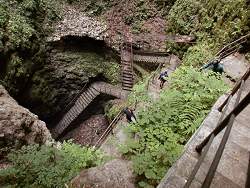

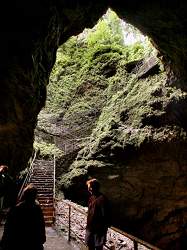
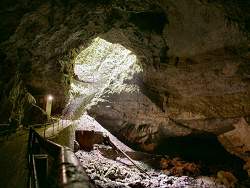

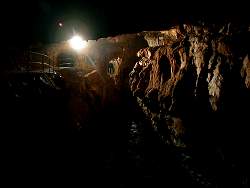
Pivka Jama and Črna Jama (Black Cave) are two parts of the Postojna cave system.
They are connected by an artificial tunnel, and the tours always show both caves together.
Unfortunately the tours of Pivka and Črna were discontinued in 2024 for undisclosed reasons.
Most likely they were simply not profitable enough.
Nevertheless, there are now the so-called Trek through Three Caves, which starts with a train ride into Postojna Cave, and a walk on the regular tour route to the far end.
An artificial tunnel which was constructed by the Italian military during the Italian occupation after World War I connects to Črna Jama.
Then the tour through Črna and Pivka Jama is made in the opposite direction.
This 2-hour tours are now offered once a day in July and August and are by far the most expensive cave tours in Slovenia.
The full tour of Postojna with two train rides costs € 30, the old tour Pivka/Črna Jama cost about € 10 to 15 before it was discontinued.
That’s € 45, and the new tour, where you miss half of the Postojna Tour and the second train ride, cost twice as much.
That’s why we listed this cave as
 The Most Expensive Show Cave
of Slovenia.
The Most Expensive Show Cave
of Slovenia.
The river Pivka is the main branch of the underground river system which formed the Postojna cave system, the name is spoken Pjooka. Its spring is southeast of the village Postojna, in an area with many dolines and seasonal lakes. At the border to the insoluble flysch rocks, the Postojna Polje, the river starts to flow over ground, until it reaches the border to the limestone at Postojna. Here the water sinks into the main entrance of Postojna Cave, flowing through the lower level of the cave system. Many parts of this cave are underwater and still unexplored. Various parts of the upper level, though not connected, were discovered through different entrances and got different names. There is a doline going down to a huge chamber which was called Črna Jama, and there is a second doline going down to a huge river passage called Pivka Jama.
The connection between these caves is obvious, a look at the cave map is enough. The river flows from the Postojnska Jama to the Otoska Jama (Island Cave). Further downstream the Pivka forms two branches, the left one through Magdalena Jama to Crna Jama, the right branch through Perkov Rov (Perkogang) and Vilharjev Rov (Vilhargang) to Crna Jama, and then through Krozni Rov to Pivka Jama, where the two branches meet again. This point, where the two branches meet, is part of the tourist route, it is the siphon where the river passage is actually left.
Originally, the connection between the caves was just a guess, although quite obvious, and not proven. Later, the connection was proven by dye tracing experiments. Still, speleologists generally require a connection which is explored by a caver, to make the connection. This has been accomplished by Édouard Alfred Martel in 1893, the sumps he could not cross were later crossed by cave divers. But the cave is also connected to nearby Planiska Jama, again the connection was proven by dye tracing experiments. But although cave divers explored 950 m downstream, there are still 1,500 m which are not explored.
Pivka Jama is located at the bottom of a steep doline, the collapse of the ceiling of its huge cave passage. The debris was continually removed by the flowing water, and so today it is gone and the cave is open and accessible from the surface. However, accessible is not the right term. Originally the steep hole in the ground, in the middle of a nice forrest, was just a danger to careless hikers or grazing animals. But after World War I the area around Postojna became Italian, and the border was nearby. To protect their border, and to get a secret connection to Planinska jama, which was located in the Kingdom Yugoslavia. the Italian Army also developed the cave with paths and electric light, the show cave is a side product of the startegic tunnel. The tunnel to Planinska Jama failed and was abandoned, today it is a dead end.
If you visit Pivka Jama today, you simply follow the signs to the cave and the homonymous campground form Postojna. The road ends at the campground, which is located in the forest around the cave entrance. You can park your car at the visitor parking in front of the door and purchase your cave tickets at the campground office. After two minutes’ walk, you reach the cave entrance. A belvedere, an outlook, is worth the few additional meters, as it shows the whole entrance doline. The rest of the time to the next tour, you can spend quite comfortable at the campground restaurant drinking a cup of coffee or a beer.
The first part of the tour is a 70 m deep descent into the doline, until you finally reach the river passage. To the left is the sump downstream towards Planinska Jama. The path now follows the river upstream, mostly along the water, sometimes through side passages, where the river cave is too narrow or completely filled by the river. Finally, the path leads through a side passage and a short tunnel up into Črna Jama.
Črna Jama (Black Cave) was named after the black colour of the speleothems. Typically, humans with torches and other open-fire light sources produced smoke which stained the speleothems. But in this cave it was different, the speleothems were already black when the first visitors entered the cave. A theory says that smoke from huge fires outside entered the cave and dyed the speleothems. During the Ice Age, when the temperature was rather low, the area was more or less like steppe, and often the dry remains of trees and bushes caught fire. This makes the stalagmites of this cave a valuable resource for climatology research.
Črna Jama is more or less a single big chamber. The floor was levelled and the room was used for festivities like several other cave chambers in the area. An artificial tunnel at the far end of the chamber connects it to Postojnska jama. However, this chamber, although the biggest chamber in the cave system, was not used very often for events. The problem is the entrance, which is at the bottom of a huge doline, formed like a bowl. This makes it a cold trap, which allows cold air during winter to flow into the cave. During summer the cold and heavier air stays in the cave, there is no exchange with the warm air outside. That’s actually the principle how Ice Caves work. In this case, the temperature is not deep enough for ice stalagmites during summer, only during winter, but nevertheless it is probably the coldest part of the whole cave system. And attending a concert in a freezer is not very tempting.

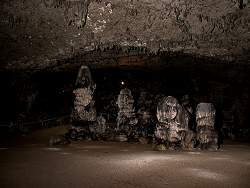
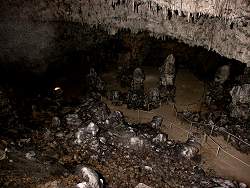

 Search DuckDuckGo for "Pivka Jama"
Search DuckDuckGo for "Pivka Jama" Google Earth Placemark
Google Earth Placemark OpenStreetMap
OpenStreetMap Pivka Jama
Pivka Jama  - Wikipedia (visited: 19-JUN-2024)
- Wikipedia (visited: 19-JUN-2024) Pivka and Black Caves, official website (visited: 13-AUG-2020)
Pivka and Black Caves, official website (visited: 13-AUG-2020) Index
Index Topics
Topics Hierarchical
Hierarchical Countries
Countries Maps
Maps